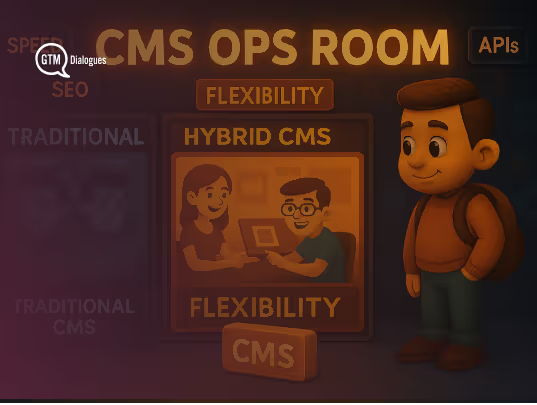I recently met a SaaS founder who built an AI-powered hiring tool to help HR teams screen candidates. The product worked well, and early adopters were intrigued. However, after months of pushing sales, he realized his real users weren’t HR teams.
The ones who loved his product? Freelancers looking for AI-driven resume optimization.
He was stuck. Should he keep chasing HR buyers who weren’t converting, or should he pivot to serve the audience already showing demand?
Research from CB Insights shows that 35% of startups fail (gated research) because there’s no market need for their product—but the smartest ones don’t shut down; they adapt. In SaaS, a well-timed pivot isn’t a failure; it’s often the key to survival.
If you’re wondering whether your SaaS needs to pivot or how to do it without blowing up everything you’ve built, this guide is for you. We’ll break down the signals that it’s time to pivot, the different types of pivots, and how to execute one without losing your existing momentum.
Because let’s be real: stubbornly sticking to a flawed plan is the real risk. Knowing when and how to shift can be the difference between another failed startup and a breakout success.
What is a Business Pivot?
A business pivot refers to a strategic shift in a company's direction, focus, or operations to better align with market demands, customer needs, or evolving industry conditions. It often involves redefining the business model, product offerings, target audience, or overall strategy to address challenges or seize new opportunities.
In the SaaS world, pivots are particularly common because digital products can be adapted more quickly than physical ones, and early-stage startups often discover their initial assumptions need refinement after market exposure.
Signs It’s Time to Pivot Your SaaS
Most SaaS founders don’t wake up one morning and decide to pivot. The need to pivot creeps up over time. This can be
1. You Have Users, But They’re Not Who You Expected
The founder I mentioned earlier built a hiring tool for HR teams, but freelancers were the ones using it. If the market you planned to serve isn’t the one actually engaging with your product, you have two options: fight the market or follow the demand.
Ask yourself:
- Who are my most engaged users today?
- Are they the ones we originally built this for?
- If not, why do they love it when our target audience doesn’t?
Pivot Strategy: Reposition your product to serve the market that’s already responding positively instead of forcing it on a disinterested audience.
2. Sales Cycles Are Long and Painful (or Deals Keep Falling Apart)
If every sale feels like pushing a boulder uphill, it might not be a sales problem—it might be a market problem. When customers hesitate, ghost you, or stall deals, it’s often a sign of low urgency or weak product-market fit.
Some red flags to look for:
- Your target customers love the idea of your product but never commit.
- Demos go well, but pricing objections always kill the deal.
- The sales cycle is longer than expected, burning cash with little return.
Pivot Strategy: Explore different go-to-market strategies, pricing models, or customer segments to find a market with stronger demand.
3. Churn Is High—Even Among Happy Customers
If users like your product but don’t stick around, you have a retention problem. The reason? Your solution might be nice-to-have, not must-have.
What to check?
- Are customers canceling because they don’t see long-term value?
- Is your product a “nice add-on” instead of a critical tool?
- Are users adopting only parts of your software while ignoring key features?
Pivot Strategy: Double down on your stickiest features or refine your core value proposition to turn casual users into power users.
4. The Market Is Too Small to Sustain Growth
Sometimes, your SaaS idea is solid, but the market just isn’t big enough. Maybe your niche is too specialized, or there aren’t enough customers willing to pay.
For example, ZenDesk started as a simple ticketing system but realized that businesses needed a full-service customer support platform. By expanding their offering beyond just ticketing, they transformed into a category leader serving companies of all sizes.
Pivot Strategy: Expand into adjacent markets without losing your differentiator. If your total addressable market (TAM) is shrinking, find a bigger pond.
5. Your Core Metrics Are Flat (or Declining)
If revenue, user growth, or engagement have stalled—even with increased marketing and sales efforts—you might be hitting a ceiling with your current positioning.
For example, Slack started as a gaming company (Tiny Speck) but pivoted into workplace communication when it became clear the gaming market wasn’t large enough to sustain the business.
Some warning signs to look for:
- Organic referrals and word-of-mouth are low.
- Paid acquisition costs are rising while conversion rates drop.
- Product usage data shows flat or declining engagement.
Pivot Strategy: Run small experiments—test new positioning, features, or distribution channels—to find where momentum still exists.
6. Competitors Are Winning, and You Can’t Catch Up
If your biggest competitor is eating your lunch, and you’re constantly reacting instead of leading, it’s time to rethink your approach.
What to evaluate?
- Are competitors offering something fundamentally better or just different?
- Is your pricing, product, or positioning what’s holding you back?
- Can you differentiate in a way that matters to your audience?
Pivot Strategy: If you’re competing in a crowded, feature-driven market, consider a vertical pivot—specializing in a niche or underserved segment instead of going head-to-head.
7. Customers Use Your Product Differently Than Expected
You built it for one use case, but customers keep hacking it for something else. This is a huge signal that you may be targeting the wrong problem—or that a new opportunity is emerging.
For example, Shopify originally started as an online snowboard store before pivoting into ecommerce software because more people were asking about the tech behind the store than the products themselves.
Pivot Strategy: Pay attention to how power users interact with your product and consider leaning into unexpected use cases that have organic traction.
Key Pivoting Types in a SaaS Startup
When considering a pivot, it's helpful to understand the different types of strategic shifts available to SaaS companies. Each type of pivot maintains certain elements of your business while changing others. Here's a breakdown of the most common pivoting strategies for SaaS startups:
| Pivot Type | Description | SaaS Example | |||||||||||||||||||||||||||||||||||||||||||||||||||||||
|---|---|---|---|---|---|---|---|---|---|---|---|---|---|---|---|---|---|---|---|---|---|---|---|---|---|---|---|---|---|---|---|---|---|---|---|---|---|---|---|---|---|---|---|---|---|---|---|---|---|---|---|---|---|---|---|---|---|
| Customer Pivot | Keeping your core product but targeting an entirely different user base | Slack: Initially built for game developers, they discovered their internal communication tool had broader appeal and pivoted to target all workplace teams | |||||||||||||||||||||||||||||||||||||||||||||||||||||||
| Problem Pivot | Shifting to address a different (often adjacent) customer problem while serving the same market | Zendesk: Moved from basic ticket management to solving comprehensive customer support challenges for businesses | |||||||||||||||||||||||||||||||||||||||||||||||||||||||
| Solution Pivot | Changing how you solve a problem while continuing to serve the same customer need | Netflix: Transitioned from DVD rentals by mail to streaming, addressing the same entertainment need through new technology | |||||||||||||||||||||||||||||||||||||||||||||||||||||||
| Technology Pivot | Adopting new technical approaches to improve how you deliver your solution | Shopify: Evolved from a single-store platform to an API-driven ecosystem that enables third-party developers to extend core functionality |
| Audience | What They Need to Hear | Best Communication Channels |
|---|---|---|
| Customers | How this makes their experience better, what’s changing, and what’s staying the same. | Email, blog post, in-app messages, social media |
| Investors | Why this is a strategic move, expected financial impact, and growth potential. | Investor updates, pitch decks, press releases |
| Employees | What this means for their roles, company vision, and execution plan. | All-hands meetings, internal docs, Slack updates |
For example, when Dunkin’ dropped “Donuts” from its name, they made sure different audiences understood the shift - customers saw it as expanded offerings, while investors saw it as a long-term strategy.
4. Use Multiple Channels for a Unified Announcement
Your announcement should hit all key platforms at the same time to avoid misinformation and confusion.
Where to announce?
✔ Website: Blog post explaining the pivot
✔ Email: Personalized message to existing customers
✔ Social Media: Branded announcement posts
✔ In-App Messaging: Notify active users inside your platform
✔ PR & Press Releases: Targeted outreach to industry publications
✔ Customer Support: Equip your team with scripts to answer questions
For example, when Instagram pivoted from Burbn, they published a clear blog post, updated their social media, and ensured their support team had responses ready.
5. Make the Transition Seamless for Existing Users
A pivot can cause friction if customers feel like they’re forced into change. The smoother the transition, the better your adoption rate.
How to make it easy?
- Give users time to adjust—don’t rip away familiar features overnight.
- Offer tutorials or onboarding help for new workflows.
- Keep key functionalities intact if possible, so the shift doesn’t feel like starting from scratch.
For example, Netflix gradually shifted to streaming while still offering DVDs, allowing customers to transition naturally.
6. Engage & Involve Your Community
People support what they feel part of. Instead of just announcing the pivot, bring your audience into the conversation.
Ways to involve customers:
- Host a live Q&A or webinar to explain the pivot.
- Encourage beta testers to share feedback on early versions.
- Run polls or surveys to gauge customer sentiment and refine messaging.
For example, Mailchimp’s rebrand included behind-the-scenes content, making users feel included in the evolution.
7. Track Feedback & Adjust Messaging as Needed
A pivot is an ongoing process. You need to monitor reactions, track adoption, and refine messaging based on real feedback.
What to track post-announcement?
✔ Engagement metrics—email open rates, blog traffic, social shares
✔ Customer sentiment—survey responses, social media reactions
✔ Churn & retention—are users sticking around or dropping off?
✔ Support inquiries—are people confused or concerned?
How to respond?
- Address concerns quickly—if users are confused, clarify messaging.
- Iterate based on feedback—adjust onboarding or features as needed.
- Reinforce the pivot’s benefits—remind users why this shift is good for them.
For example, Airbnb faced early skepticism about their rebrand, but by staying consistent with their messaging and emphasizing trust and belonging, they turned criticism into loyalty.
The way you communicate your pivot determines whether users embrace or resist it. By owning the narrative, giving users time to adjust, and making the transition easy, you turn your pivot into an opportunity for excitement, not confusion.
Real-World SaaS Pivot Success Stories (And What You Can Learn From Them)
Not all pivots succeed—but the ones that do often define entire industries. The best SaaS pivots don’t happen by accident; they come from listening to users, identifying hidden demand, and executing strategically.
Here are some real-world SaaS pivot success stories and the key lessons you can apply to your own startup. (And we might have already discussed some of it above)
1. Slack: From Gaming Failure to Workplace Essential
🎯 Original Idea: A gaming company (Tiny Speck) developing an online multiplayer game.
🔄 Pivot: The team’s internal chat tool turned out to be more valuable than the game itself—so they pivoted to workplace communication.
🚀 Result: Slack became a category-defining SaaS company, later acquired by Salesforce for $27.7 billion.
📌 Key Lesson: Watch how users actually engage with your product. If they’re using it in unexpected ways, there could be a hidden market opportunity.
2. Shopify: From Snowboards to E-commerce Empire
🎯 Original Idea: A direct-to-consumer snowboard store selling gear online.
🔄 Pivot: While trying to sell their own products, the founders built a powerful e-commerce platform—and realized other businesses needed it.
🚀 Result: Shopify is now a multi-billion-dollar SaaS company, powering over 4 million online stores.
📌 Key Lesson: Your internal tools might be more valuable than your original idea. Pay attention to what other people want from your product, even if that wasn’t the original intention.
3. Zoom: From a Crowded Market to Market Leader
🎯 Original Idea: A video conferencing tool in a saturated market dominated by WebEx and Skype.
🔄 Pivot: Instead of competing head-to-head, Zoom focused on simplicity, ease of use, and video quality, targeting businesses frustrated with complex tools. 🚀 Result: Zoom grew into a $100+ billion company, becoming the default video conferencing tool for remote work.
📌 Key Lesson: You don’t need to create a new category—just solve a problem better. Sometimes, refining an existing solution is enough to dominate a market.
4. Instagram: From a Complicated App to a Photo-First Platform
🎯 Original Idea: Burbn, a location-based app with check-ins, social features, and photo sharing.
🔄 Pivot: The founders noticed users only cared about the photo-sharing feature—so they stripped everything else away.
🚀 Result: Instagram became one of the most successful social media platforms, later acquired by Facebook for $1 billion.
📌 Key Lesson: If users are ignoring most of your product but love one feature—double down on that feature. Simplicity wins.
5. Zendesk: Expanding Beyond a Niche Market
🎯 Original Idea: A simple customer service ticketing system for small businesses.
🔄 Pivot: The team realized that larger businesses needed more robust customer support solutions—so they expanded into a full customer experience platform. 🚀 Result: Zendesk became a leader in customer service software, now serving businesses of all sizes.
📌 Key Lesson: If your market is too small, look at how you can expand into adjacent opportunities—without losing your core differentiation.
6. Twitter: From Podcasting Failure to Social Media Giant
🎯 Original Idea: Odeo, a platform for podcast hosting and discovery.
🔄 Pivot: When Apple launched iTunes Podcasting, Odeo’s business model collapsed. Instead of shutting down, the team pivoted to a microblogging platform where users could share quick updates. 🚀 Result: Twitter became one of the world’s most influential social media platforms.
📌 Key Lesson: If a market shift makes your product obsolete, don’t fight it—adapt to a new opportunity.
7. YouTube: From Dating App to Video Revolution
🎯 Original Idea: A video-based dating platform where users uploaded clips to introduce themselves.
🔄 Pivot: The founders noticed users were uploading all kinds of videos, not just dating intros. Instead of forcing their original idea, they pivoted into a general video-sharing platform. 🚀 Result: YouTube became the second-largest search engine in the world, later acquired by Google for $1.65 billion.
📌 Key Lesson: If users are repurposing your product in unexpected ways, lean into it. Your biggest opportunity might be hiding in plain sight.
8. Netflix: From DVD Rentals to Streaming Powerhouse
🎯 Original Idea: A DVD rental service competing with Blockbuster.
🔄 Pivot: As broadband speeds improved, Netflix shifted to on-demand streaming, eventually phasing out DVDs.
🚀 Result: Netflix is now one of the biggest media companies in the world, with over 200 million subscribers.
📌 Key Lesson: Think ahead—if industry trends are changing, position yourself early instead of playing catch-up.
What These Success Stories Have in Common
- They listened to their users. Almost every successful pivot happened because founders paid attention to how people were actually using their product.
- They didn’t cling to their original idea. The best founders don’t get emotionally attached to a failing concept—they adapt when the market demands it.
- They focused on market needs, not just product features. Instead of obsessing over what they built, these companies focused on what people actually wanted.
- They executed with confidence. Once they committed to a pivot, they went all in and communicated their vision clearly.
The best founders don’t see pivots as failures—they see them as part of the journey. A well-executed pivot can be the difference between a struggling startup and an industry leader.
Now it’s your turn: Is your SaaS business showing signs that a pivot might be necessary? Or do you just need better execution?
The Ultimate Pivot Checklist: Everything You Need to Cover Before Making the Shift
A pivot isn’t just a decision—it’s a process. Rushing into a pivot without preparation can be as dangerous as not pivoting at all. To ensure a smooth transition, you need a clear plan that minimizes risks, keeps customers engaged, and sets you up for success.
Use this Ultimate Pivot Checklist to make sure your pivot is strategic, well-executed, and positioned for growth.
Here’s your Ultimate Pivot Checklist in a structured table format for easy tracking. ✅
The Ultimate Pivot Checklist: Everything You Need Before Making the Shift
| Category | Action Item | Yes/No | |||||||||||||||||||||||||||||||||||||||||||||||||||||||
|---|---|---|---|---|---|---|---|---|---|---|---|---|---|---|---|---|---|---|---|---|---|---|---|---|---|---|---|---|---|---|---|---|---|---|---|---|---|---|---|---|---|---|---|---|---|---|---|---|---|---|---|---|---|---|---|---|---|
| 1. Validate Whether a Pivot is Truly Necessary | Have you identified clear signs that your current model isn’t working? | ||||||||||||||||||||||||||||||||||||||||||||||||||||||||
| Have you ruled out optimizing sales, marketing, or pricing instead of pivoting? | |||||||||||||||||||||||||||||||||||||||||||||||||||||||||
| Is your market too small, declining, or overly competitive? | |||||||||||||||||||||||||||||||||||||||||||||||||||||||||
| Are you seeing consistent demand for a different use case, audience, or product feature? | |||||||||||||||||||||||||||||||||||||||||||||||||||||||||
| 2. Define Your New Direction | Have you clearly defined your new core audience (personas, market size, pain points)? | ||||||||||||||||||||||||||||||||||||||||||||||||||||||||
| Does your new direction align with your team’s strengths and existing technology? | |||||||||||||||||||||||||||||||||||||||||||||||||||||||||
| Have you validated demand through customer interviews, market research, or pilot tests? | |||||||||||||||||||||||||||||||||||||||||||||||||||||||||
| Do you have a unique value proposition that differentiates your pivoted offering? | |||||||||||||||||||||||||||||||||||||||||||||||||||||||||
| 3. Secure Internal Buy-In (Team & Investors) | Have you explained the “why” behind the pivot to your team? | ||||||||||||||||||||||||||||||||||||||||||||||||||||||||
| Do employees understand what’s changing, what’s staying the same, and how their roles will be affected? | |||||||||||||||||||||||||||||||||||||||||||||||||||||||||
| Have you addressed investor concerns with a clear business case and growth projections? | |||||||||||||||||||||||||||||||||||||||||||||||||||||||||
| Do key decision-makers (executives, department leads) fully support the pivot? | |||||||||||||||||||||||||||||||||||||||||||||||||||||||||
| 4. Develop a Pivot Roadmap | Have you broken down the pivot into phases instead of an overnight switch? | ||||||||||||||||||||||||||||||||||||||||||||||||||||||||
| Do you have a clear timeline for product updates, messaging changes, and marketing rollout? | |||||||||||||||||||||||||||||||||||||||||||||||||||||||||
| Have you identified what parts of the existing product, branding, and operations can be retained? | |||||||||||||||||||||||||||||||||||||||||||||||||||||||||
| Are internal teams (marketing, sales, support) fully briefed on the rollout plan? | |||||||||||||||||||||||||||||||||||||||||||||||||||||||||
| 5. Announce & Communicate the Pivot Properly | Have you crafted a clear, customer-first announcement that explains the benefits? | ||||||||||||||||||||||||||||||||||||||||||||||||||||||||
| Have you segmented messaging for different audiences (customers, investors, employees)? | |||||||||||||||||||||||||||||||||||||||||||||||||||||||||
| Are multiple channels (email, website, social, press, in-app messaging) aligned for a unified launch? | |||||||||||||||||||||||||||||||||||||||||||||||||||||||||
| Have you prepared customer support teams with FAQs and response scripts? | |||||||||||||||||||||||||||||||||||||||||||||||||||||||||
| 6. Ensure a Smooth Transition for Existing Users | Are you providing a transition peWhat to Keep, Salvage, and Reuse During a Pivot?A successful pivot doesn't mean starting from scratch. Smart SaaS founders identify valuable assets to preserve while making strategic changes. Here's what you should consider keeping, salvaging, and reusing during your pivot:
By thoughtfully evaluating what to maintain, you can preserve momentum while still making necessary strategic shifts. This balanced approach allows you to build on existing strengths rather than discarding everything that came before. Pivoting is Not a Reset—It’s an EvolutionPivoting isn’t about admitting failure—it’s about adapting to opportunity. The best SaaS founders know that success isn’t about stubbornly sticking to the original plan; it’s about staying flexible, listening to the market, and making bold yet calculated moves. If you’ve made it this far, you now have: ✅ A clear framework for deciding whether to pivot or persevere. ✅ A step-by-step process for executing a pivot without losing momentum. ✅ A communication strategy to ensure your customers, investors, and team embrace the change. ✅ A real-world playbook of SaaS pivot success stories to learn from. The Last Question: Are You Ready to Pivot or Double Down?Before making any move, ask yourself: 🔹 Have I truly optimized my current strategy, or am I pivoting out of frustration? 🔹 Is there real demand for this new direction, backed by data? 🔹 Can I execute the pivot smoothly without alienating existing customers? The most successful startups don’t pivot on impulse—they pivot with intention. If your market signals say it’s time, don’t hesitate. But if refinement and persistence can get you to the next level, stay the course. Whatever path you choose, commit fully, execute with confidence, and own your story. Are you pivoting because it’s necessary—or because it’s easier than optimizing? Choose wisely. Your startup’s future depends on it. Frequently Asked QuestionsHow long does a pivot typically take for a SaaS business?Most SaaS pivots take 6-12 months, depending on complexity. Customer or market pivots can move faster (3-6 months), while technology or product pivots may take longer (9-18 months). The best approach is phased—start small, test early, and roll out changes gradually. When should a SaaS pivot involve rebranding?Only if your current brand limits your new direction, carries negative associations, or represents a fundamental identity shift. Otherwise, it’s better to preserve brand recognition and reposition instead of rebrand—like HubSpot, which expanded from marketing into a full CRM while keeping its name. What strategies help keep customers engaged during a pivot?Clear communication is key—customers need to understand how the pivot benefits them. Involving early adopters through beta programs, offering loyalty incentives like grandfathered pricing, and providing strong support resources ensure a smoother transition and maintain trust. What's the most common mistake SaaS startups make when pivoting?Pivoting without validation. Many startups pivot too soon, only to pivot again when the new direction fails. Always test the new approach with market research, customer feedback, and small experiments before fully committing. A close second? Poor communication—unclear messaging erodes trust with customers and your team.   Saurabh Lahoti Saurabh Lahoti is the founder of GTMDialogues, helping early-stage B2B startups scale with sharper GTM strategy, inbound marketing, and founder-led storytelling.
Learn More About Product Led Growth |





























